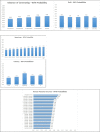The impact of working from home on modal commuting choice response during COVID-19: Implications for two metropolitan areas in Australia
- PMID: 34840440
- PMCID: PMC8608599
- DOI: 10.1016/j.tra.2021.11.011
The impact of working from home on modal commuting choice response during COVID-19: Implications for two metropolitan areas in Australia
Abstract
The need to recognise and account for the influence of working from home on commuting activity has never been so real as a result of the COVID-19 pandemic. Not only does this change the performance of the transport network, it also means that the way in which transport modellers and planners use models estimated on a typical weekday of travel and expand it up to the week and the year must be questioned and appropriately revised to adjust for the quantum of working from home. Although teleworking is not a new phenomenon, what is new is the ferocity by which it has been imposed on individuals throughout the world, and the expectation that working from home is no longer a temporary phenomenon but one that is likely to continue to some non-marginal extent given its acceptance and revealed preferences from both many employees and employ where working from home makes good sense. This paper formalises the relationship between working from home and commuting by day of the week and time of day for two large metropolitan areas in Australia, Brisbane and Sydney, using a mixed logit choice model, identifying the influences on such choices together with a mapping model between the probability of working from home and socioeconomic and other contextual influences that are commonly used in strategic transport models to predict demand for various modes by location. The findings, based on Wave 3 (approximately 6 months from the initial outbreak of the pandemic) of an ongoing data collection exercise, provide the first formal evidence for Australia in enabling transport planners to adjust their predicted modal shares and overall modal travel activity for the presence of working from home.
Keywords: Australian experience; COVID-19; Commuter mode choice; Elasticities; Mixed logit model; Segment mapping for WFH propensity; Value of time; Working from home.
© 2021 Elsevier Ltd. All rights reserved.
Conflict of interest statement
The authors declare that they have no known competing financial interests or personal relationships that could have appeared to influence the work reported in this paper.
Figures
















Similar articles
-
Slowly coming out of COVID-19 restrictions in Australia: Implications for working from home and commuting trips by car and public transport.J Transp Geogr. 2020 Oct;88:102846. doi: 10.1016/j.jtrangeo.2020.102846. Epub 2020 Sep 2. J Transp Geogr. 2020. PMID: 32904879 Free PMC article.
-
Working from home and its implications for strategic transport modelling based on the early days of the COVID-19 pandemic.Transp Res Part A Policy Pract. 2021 Jun;148:64-78. doi: 10.1016/j.tra.2021.03.027. Epub 2021 Apr 2. Transp Res Part A Policy Pract. 2021. PMID: 35702388 Free PMC article.
-
Accounting for the spatial incidence of working from home in an integrated transport and land model system.Transp Res Part A Policy Pract. 2023 Jul;173:103703. doi: 10.1016/j.tra.2023.103703. Epub 2023 May 24. Transp Res Part A Policy Pract. 2023. PMID: 37256162 Free PMC article.
-
Australia 6 months after COVID-19 restrictions part 2: The impact of working from home.Transp Policy (Oxf). 2022 Nov;128:274-285. doi: 10.1016/j.tranpol.2021.06.005. Epub 2021 Jun 10. Transp Policy (Oxf). 2022. PMID: 35720049 Free PMC article.
-
Influence of Working From Home During the COVID-19 Crisis and HR Practitioner Response.Front Psychol. 2021 Sep 23;12:710517. doi: 10.3389/fpsyg.2021.710517. eCollection 2021. Front Psychol. 2021. PMID: 34630219 Free PMC article. Review.
Cited by
-
Working from home in Australia in 2020: Positives, negatives and the potential for future benefits to transport and society.Transp Res Part A Policy Pract. 2022 Apr;158:271-284. doi: 10.1016/j.tra.2022.03.016. Epub 2022 Mar 14. Transp Res Part A Policy Pract. 2022. PMID: 36568131 Free PMC article.
-
Traveller behaviour in public transport in the early stages of the COVID-19 pandemic in the Netherlands.Transp Res Part A Policy Pract. 2022 May;159:357-371. doi: 10.1016/j.tra.2022.03.027. Epub 2022 Mar 22. Transp Res Part A Policy Pract. 2022. PMID: 35345770 Free PMC article.
-
Telework and MaaS adoption in a post-pandemic scenario. Evidence from municipal employees of Padua, Italy.Case Stud Transp Policy. 2023 Jun;12:101010. doi: 10.1016/j.cstp.2023.101010. Epub 2023 Apr 27. Case Stud Transp Policy. 2023. PMID: 37153124 Free PMC article.
-
Quantifying the impact of COVID-19 on travel behavior in different socio-economic segments.Transp Policy (Oxf). 2023 Jun;136:98-112. doi: 10.1016/j.tranpol.2023.03.014. Epub 2023 Mar 23. Transp Policy (Oxf). 2023. PMID: 37008070 Free PMC article.
-
Exploring how worthwhile the things that you do in life are during COVID-19 and links to well-being and working from home.Transp Res Part A Policy Pract. 2023 Feb;168:103579. doi: 10.1016/j.tra.2022.103579. Epub 2023 Jan 4. Transp Res Part A Policy Pract. 2023. PMID: 36618015 Free PMC article.
References
-
- Anders, G. (2020) Workforce Confidence Index: Introducing a biweekly pulse on the mood of workers, Linkedin Workforce Insights, https://www.linkedin.com/pulse/workforce-confidence-index-introducing-bi..., accessed 13/08/20.
-
- Balbontin, C., Hensher, D.A., Beck, M.J., Giesen, R., Basnak, P., Vallejo-Borda, J.A., Venter, C. Impact of COVID-19 on the number of days working from home and commuting travel: A cross-cultural comparison between Australia, South America and South Africa, submitted to J. Transp. Geography, 10 May 2021. - PMC - PubMed
-
- Barrero,J.M., Bloom, N., Davis, S.J. (2021) Why working from home will stick, National Bureau of Economic Research Working Paper 2873, April http://www.nber.org/papers/w28731.
-
- Beck M., Hensher D.A. Insights into the Impact of Covid-19 on Household Travel, Work, Activities and Shopping in Australia – the early days under restrictions, Paper #1. Transp. Policy. 2020;96:76–93. doi: 10.1016/j.tranpol.2020.07.001. (one of top most downloaded papers in the journal since published) - DOI - PMC - PubMed
LinkOut - more resources
Full Text Sources
